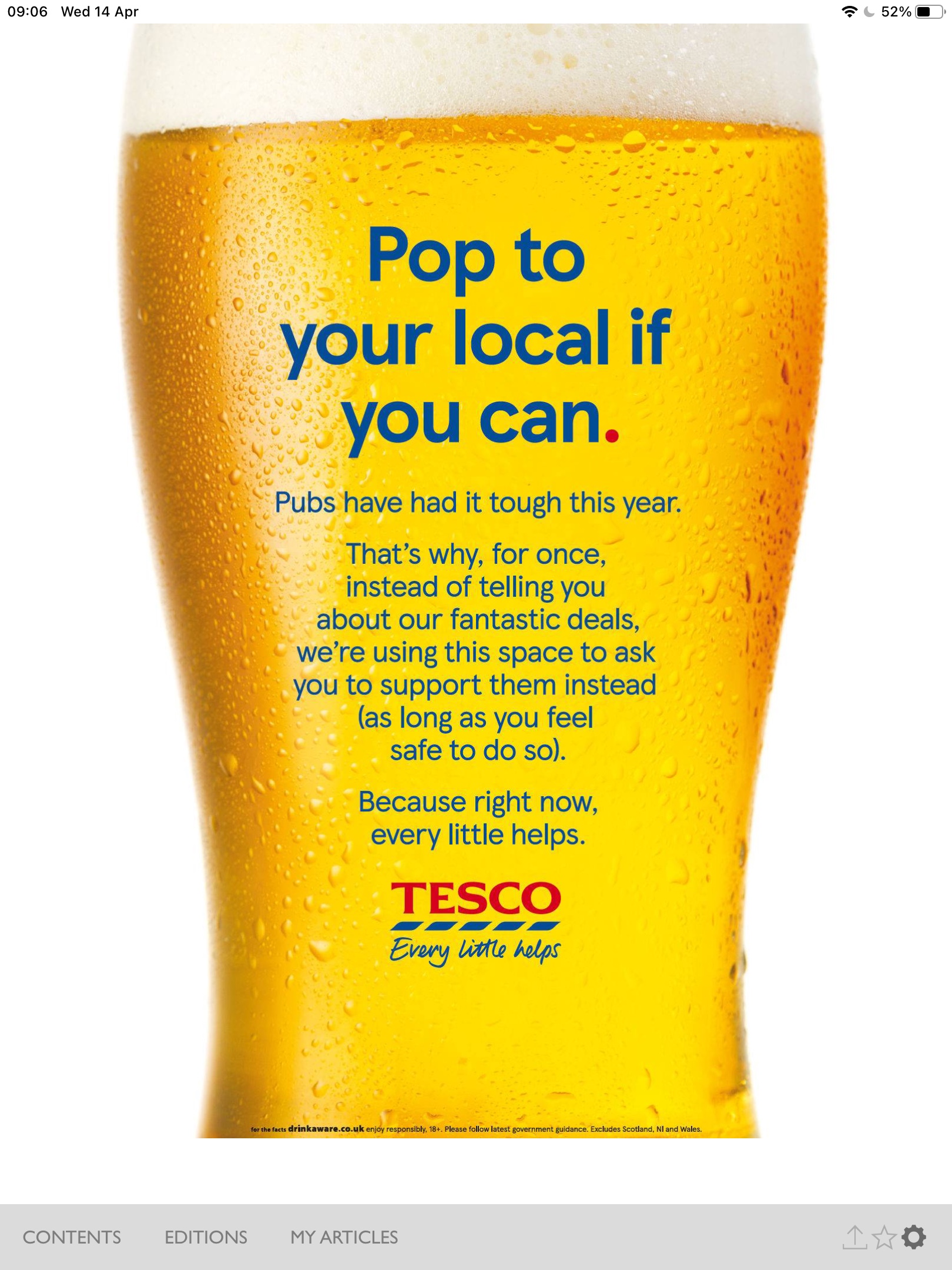League tables & gesture advertising

Dominic Mills analyses the latest league table rankings and questions Tesco’s motivation for getting us back down the pub
Yes, it’s that time of the year when agencies are subject to the tyranny of the league table.
I’m thinking here of the annual Campaign-Nielsen top 100 creative and top 50 media agencies, published last week, whose billings figures are made clear for all to see.
This allows us to play the who’s up/who’s down games we all enjoy. And yes, I know billings don’t fully reflect all their activity but this is the least subjective way we have to make a judgement.
Let’s start with the creative agencies, listed here.
It’s tempting to compare the table to the Premier League, where nothing much happens at the top year-to-year in terms of rankings — ie the top six or ten just shuffle around a place or two with monotonous regularity (Arsenal apart, heh heh).
But that is to ignore some of the longer term shifts which show that some of the big names are in a slow descent down the table.
Take AMV BBDO, down this year from second to fifth, and with billings down a third to £248 million.
You could say this just a temporary blip but in fact the decline is sharp over the last six years — from £449 million in 2018 and £511 million in 2015, on both of which occasions it sat in #1 place.
You can imagine WPP is equally concerned by the performance of its four main creative agencies, Ogilvy, Grey, VML/Y&R and Wunderman Thompson.
It wasn’t that long ago that they were pretty much nailed-on certainties for the top 10 or just outside. How some of the mighty have slumped.
In 2015 Grey was eighth — and currently 19th, with billings less than half; in 2015, Y&R as it then was sat 9th — currently it is 21st with billings down more than half.
In 2015, JWT was 17th, and today it sits 25th, with billings down from £137 million to £55 million. Only Ogilvy holds its head above water, up from 18th in 2015 with billings of £129 million to 11th today with billings of £170 million.
The engineering that glued together Wunderman with Thompson and VML with Y&R isn’t currently (or yet) making much difference in terms of scale and status. We’ll have to wait until next year to see if the AKQA/Grey sellotape adds anything.
It can’t be much fun round at Publicis London either, despite being rammed together with Poke a couple of years ago. In 2015 it sat 11th and in 2018 12th; today it is at 16th, with billings just over half its 2018 level. So much for the French London flagship.
The indies meanwhile, continue to do ok, led by VCCP, with others like Mother, W&K, Brothers & Sisters and Krow more or less holding their positions.
The exception is M&C Saatchi which, it seems hard to imagine now, was at one time bigger than its…er birth parent… Saatchi and Saatchi. Today, positions are reversed: S&S is revived and sits 6th, while M&C is 26th.
I wouldn’t presume to say there are lessons to be learned from this, other than perhaps — unlike their media sisters — creative agencies are more fragile entities and perhaps more susceptible to the vicissitudes of fashion; and perhaps that the jury is out on forced mergers.
By contrast, the top 10 media agencies are stable to the point of dullness.
The top 10-15 remain pretty much unchanged over at least a decade; WPP and other network agencies dominate — shifting a place or two up and down every year — while The7stars hangs on to its top ten ranking and Goodstuff continues to knock on the door but real scale eludes the indies.
[advert position=”left”]
It would, I think, be wrong to conclude that media agencies are more stable businesses, and it seems like the networks continue to compete in a league of their own by dominating pitch activity.
We know that scale is less of a differentiator these days, except perhaps in one respect – the comfort factor for clients.
If as promised, this year brings a pitching frenzy, we shall see.
Tesco’s meaningless gesture
There’s no doubting that Tesco’s ‘Pop to your local if you can ad’ from last Monday caught the attention of the public, and nearly all favourable too. The industry quite liked it also .

And that was initially how I felt.
“That’s quite nice of them, that’s quite fun”, I thought. Until I started asking myself, on the basis that motivation underpins all actions, ‘what do they hope to gain from this?’.
On one level, the ad has the appearance of late Covid-era iteration of all those efforts we saw around April last year. You know the type of thing: “We’re with you during this difficult time. We share your pain. We’re here to help. Just get in touch”, all set to mournful music and an on-screen caption that warns, you may never get through because they’re experiencing ‘heavier-than-normal’ call volumes — as if that was something they couldn’t anticipate and do something about.
To unpick this a little further, we need to ask two questions.
One, what did Tesco want us to do?
To which the answer is go to the pub, obvs. But, seriously, what percentage of the pub-going market did not know pubs were open again that day? Plus, what percentage thought ‘well, I hadn’t thought of going to the pub at all today but now that Tesco tells me it’s ok, I definitely will’.
Two, what did Tesco want us to feel?
To which the only answer can be what a generous, helpful, corporate citizen Tesco is, offering a helping hand to those businesses and elements of the social fabric that have suffered during lockdown.
And here’s the thing. I believe Tesco has had a great lockdown, stepping-up the plate when we needed it to; from a tiny share of the family weekly shopping basket, it now has 80-90% and I can’t see that changing.
But the sting in the tail is that the ad appeared just two days before Tesco announced its latest results, which would clearly show that, while it had taken a hit from Covid costs, it had also benefited enormously from people buying food, booze and clothing there while they couldn’t elsewhere — which they did, with like-for-likes sales up 6.3% and the first increase in market share for years.
So, to go back to the motivation, this feels like a piece of pre-emptive defensive thinking, and cynical at that.
‘Look’, they said to themselves, ‘we’re going to get it in the neck — and lots of people think our cut-price booze offers have put pubs out of business anyway — so let’s do something to deflect this.’
I can’t help thinking that if Tesco had been really serious about helping pubs it would have combined the ad with a money-off offer for those buying a pint in their local that day.
That would have cost it sure, but it would have taken the ad from being a meaningless gesture to something genuine.
As it is, Tesco just revealed the hollowness as its core.



